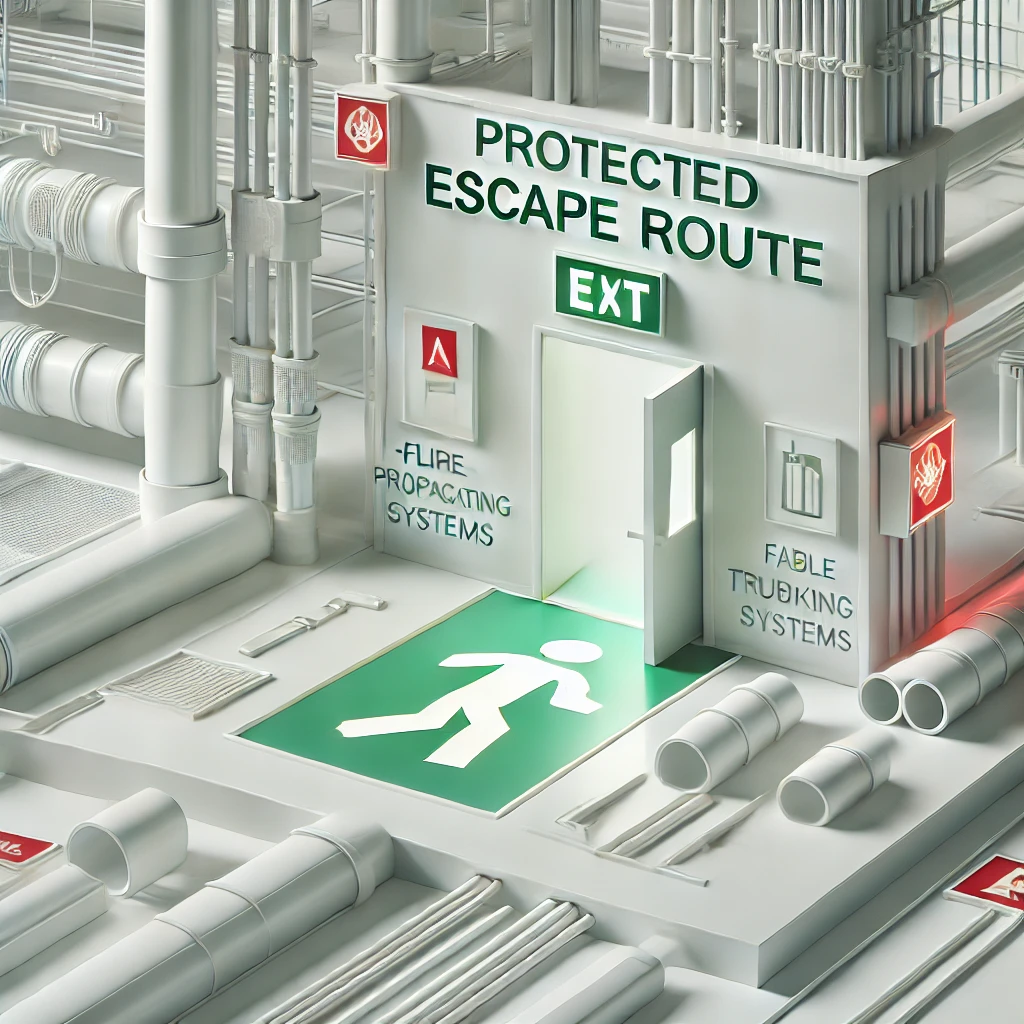What Are the Requirements for Cables in Protected Escape Routes According to BS 7671?
Regulation 422.2.1 states: Only cables that meet the following requirements shall be installed in protected escape routes...

OW London Electrician and Home Automation Engineers Team
What Are the Requirements for Cables in Protected Escape Routes According to BS 7671?
Regulation 422.2.1 states:
"Only cables that meet the following requirements shall be installed in protected escape routes:
- (i) cables meeting the requirements of 560.8.1 or cables with resistance to flame propagation according to the recommended requirements of the relevant part of BS EN 60332-3 series or, where cable management systems according to (iii) or (iv) below are used, to the recommended requirements of BS EN 60332-1-2 and
- (ii) a minimum of 60% light transmittance when tested in accordance with BS EN 61034-2.
Cables in protected escape routes shall be as short as practicable. Cables encroaching on escape routes shall not be installed within arm's reach unless they are provided with protection against mechanical damage likely to occur during an evacuation.
Where used in protected escape routes, cable management systems shall be one or more of the following types and shall be of limited smoke production so as not to inhibit escape:
(iii) conduit systems classified as non-flame propagating according to BS EN 61386
(iv) cable trunking systems and cable ducting systems classified as non-flame propagating according to BS EN 50085
(v) cable tray and cable ladder systems classified as non-flame propagating according to BS EN 61537
(vi) powertrack systems meeting the requirements of BS EN 61534.
NOTE 1: Non-fire resisting cables need to satisfy the requirements of the CPR in respect of their reaction to fire. See Appendix 2, item 7. There are no requirements in the CPR for fire resisting cables described in Regulation 560.8.
NOTE 2: Ferrous metal, e.g. steel, is deemed to be an example of a material having limited smoke production.
Cables that are supplying safety circuits shall have a resistance to fire rating of either the time authorized by regulations for building elements or British Standards for the circuits or one hour in the absence of such a regulation or standard. Refer to Regulation 560.8 for such cables."

Essential Rules for Cables in Protected Escape Routes
1. Fire-Proof It
- Requirement: Use cables that resist fire.
- Memory Tip: "If it can't stand the heat, it shouldn't be in the escape route."
2. See Through Smoke
- Requirement: Cables must not block more than 40% of light with their smoke.
- Memory Tip: "Keep it light, even in smoke."
Installation Essentials
3. Short and Safe
- Requirement: Keep cables short and out of reach unless shielded.
- Memory Tip: "Shorter is safer."
Types of Cable Management
4. Protective Pathways
- Requirement: Use protective systems like conduits, trunking, trays, or powertracks that also resist flame.
- Memory Tip: "Channel them safely."
Extra Safety for Emergency Systems
5. Critical Connection
- Requirement: Ensure cables for safety systems can withstand fire for at least an hour.
- Memory Tip: "Safety first, fire second."
Frequently Asked Questions
Q: What types of cable management systems are required in protected escape routes to limit smoke production?
A: According to regulation 422.2.1, cable management systems used in protected escape routes must be of limited smoke production to not inhibit escape. The acceptable types include conduit systems classified as non-flame propagating (BS EN 61386), cable trunking and ducting systems classified as non-flame propagating (BS EN 50085), cable tray and ladder systems classified as non-flame propagating (BS EN 61537), and powertrack systems meeting the requirements of BS EN 61534.
Q: How close to the escape route can cables be installed?
A: According to regulation 422.2.1, cables encroaching on escape routes shall not be installed within arm's reach unless they are provided with protection against mechanical damage likely to occur during an evacuation.
Q: What is the required light transmittance for cables in protected escape routes?
A: Regulation 422.2.1 specifies that cables in protected escape routes must have a minimum of 60% light transmittance when tested in accordance with BS EN 61034-2.
Q: What are the requirements for cables supplying safety circuits in terms of fire resistance?
A: Regulation 422.2.1 states that cables supplying safety circuits shall have a resistance to fire rating of either the time authorized by regulations for building elements or British Standards for the circuits, or one hour in the absence of such a regulation or standard.
Q: What are the requirements for non-fire-resisting cables in protected escape routes?
A: Regulation 422.2.1 Note 1 indicates that non-fire resisting cables need to satisfy the requirements of the CPR in respect of their reaction to fire. See Appendix 2, item 7 for further requirements.
Q: Are there any special requirements for cable length in protected escape routes?
A: Yes, according to regulation 422.2.1, cables in protected escape routes should be as short as practicable.
What users Saying
Discover what our customers think about our services. Their feedback reflects our commitment to delivering exceptional service and expert solutions for all electrical and security needs.

